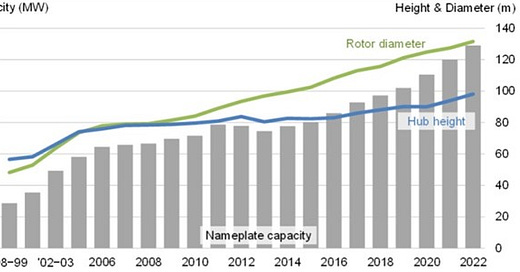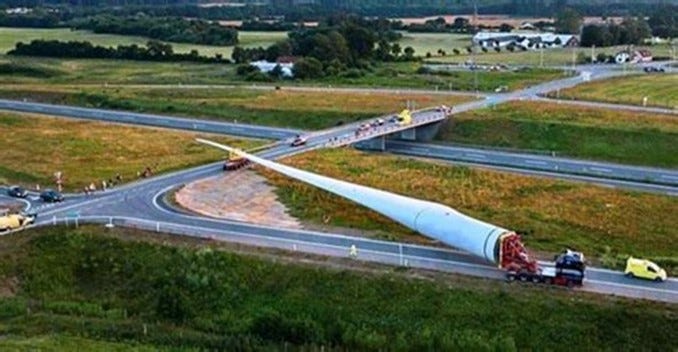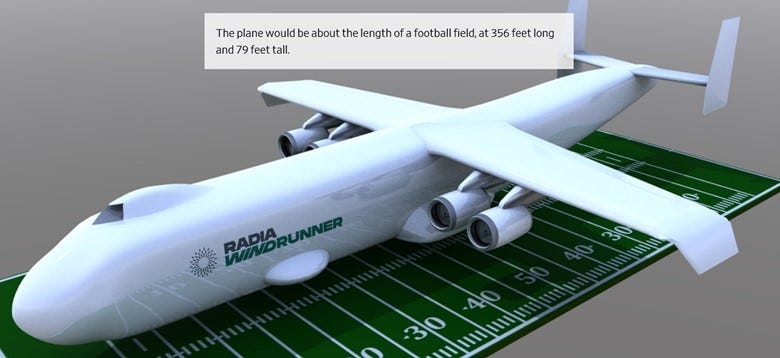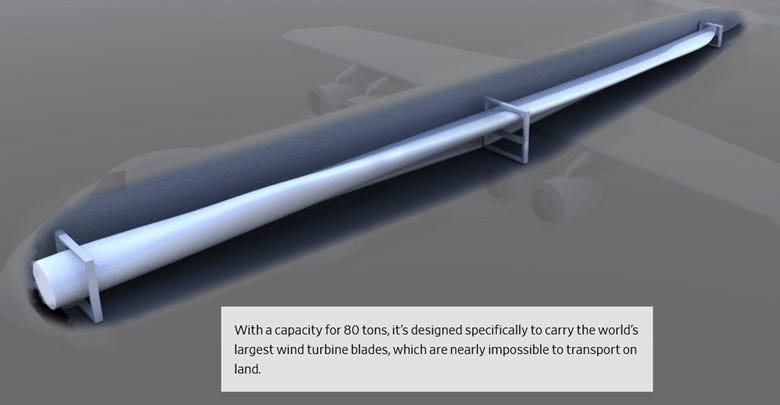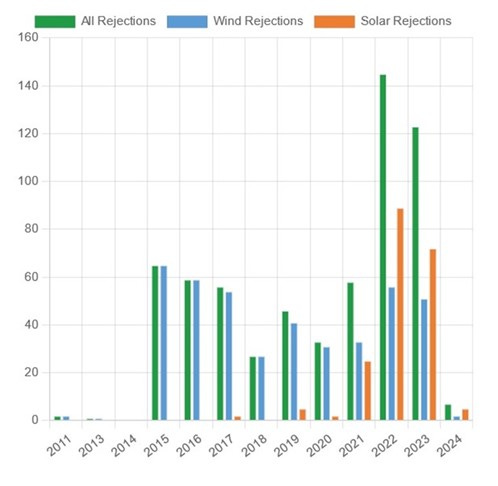Energy Musings - March 15, 2024
Building a supersized plane to carry gigantic wind turbine blades to onshore wind farms to improve their profitability and output remains questionable. Reporters promote the fairy tale story.
A Green Energy Fairy Tale In The Making
The Wall Street Journal recently carried an exclusive article about the company designing, planning to build, and seeking to certify the world’s largest airplane. The plane will ferry enormous wind turbine blades from the manufacturing plant to onshore wind farm construction sites. The article claimed the plane could “supersize wind energy.”
The company, Radia, is described by the article’s authors as “a unicorn startup” headquartered in Colorado. According to the article, Radia has raised $104 million. The venture capital investment tracking firm PitchBook says the company’s valuation is $1 billion, which justified the capital raise.
Radia was conceived by Mark Lundstrom, described as an MIT-trained rocket scientist and Rhodes scholar. The idea was spawned in 2016 when Lundstrom read about the problems the wind industry had in delivering large wind turbine blades to land wind farms.
Onshore wind turbines have grown in size as wind farm developers sought to increase the output from their turbines to reduce their output’s cost, thereby increasing profitability. However, as wind turbines have increased in size, rotor blades have lengthened. The longer the blades are, the greater the logistical challenge in getting them to wind farm construction sites.
The following chart is from the Office of Energy Efficiency & Renewable Energy in a report titled “Wind Turbines: The Bigger, The Better.” It shows how wind turbines have increased in height, rotor diameter, and nameplate capacity between the late 1990s to 2022.
Onshore wind turbines have grown larger as developers seek to maximize their earnings.
To gain a better appreciation for wind turbine growth, the following graphic from that report shows the growth of onshore wind turbines on the left-hand side of the graphic when compared to the Statue of Liberty. Offshore wind turbines, which have grown even larger over time, and are projected to grow even larger, are shown on the right-hand side of the graphic.
Look at how wind turbines onshore and offshore have increased in size over time.
While we have been on highways with trucks hauling wind turbine blades, we have never encountered a situation as shown below. We feel for those drivers and passengers in the vehicles trailing the blade as attempted to navigate the turn, a significant challenge for ever-lengthening blades. Moving large blades may require alternative routes to avoid having to pass under bridges.
You hope you never get behind one of these large wind turbine blades being driven to a construction site.
Mr. Lundstrom’s vision is to fly the blades from the manufacturing plant to the wind farm construction site. According to the article, Radia is more than halfway through the eight years it estimates will be needed to design, build, and certify the plane. The idea of a supersized plane came after other options such as using a blimp or helicopters were not capable of managing the task. Blimps have problems with dangling such a long blade underneath it, as well as being limited by windy conditions. Pairs of helicopters would be needed to lift and control such a long blade, and there are questions about whether the combined cargo-carrying capacity would be sufficient to move an 80-ton blade. Maneuverability might also be a challenge.
The Wall Street Journal’s website version of the article showed several schematics of the proposed plane that we have reproduced because the article is behind a paywall. The plane’s length, at 356 feet, is longer than a football field. It has a 262-foot wingspan and stands 79 feet tall with tires roughly five feet high. Amazingly, the plane is being designed to land on a packed-dirt 6,000-foot runway. This is because it is envisioned that wind farms will need 25 turbines to be profitable, thus each project will require a runway to be able to bring in all the turbine components.
Conceptual design of supersized plane for hauling wind turbine blades to construction sites.
Here is how a taller wind turbine blade would fit into the supersized transportation plane.
The plane would be 124 feet longer than the Boeing 747-400f transportation model. The wingspan would be 50 feet wider than the 747 and the plane would have 12-times the carrying capacity. The Radia plane would even be 80 feet longer than the largest military transport plane.
Illustrating how an oversized turbine blade would be loaded onto the Radia’s plane.
The illustration above shows how a wind turbine blade would be loaded onto the plane.
According to the article, Radia claims the larger turbines “could reduce the cost of energy by up to 35% and increase the consistency of power generation by 20% compared with today’s onshore turbines.” These are impressive claims. The U.S. Energy Information Administration’s most recent estimates of the levelized cost of electricity by fuel show the cost of new onshore wind is $31.07 per megawatt-hour. If the savings were 35%, then the cost of power could potentially drop to $20.20/MWh. In terms of the cost of electricity for a consumer, it might decline from 3.1 cents per kilowatt-hour to 2.0-ȼ/kWh. That sounds impressive, but the cost of the electricity produced by the turbine accounts for roughly 30% of the price of residential electricity. Unfortunately, these wind farms envisioned being built by using this plane would be very remote adding to the cost of getting the power from the wind farm to homes. Thus, the final electricity cost savings might be much less than suggested.
The current efficiency of onshore wind turbines is about 20%. If the larger turbines can increase the efficiency by 20%, then output might increase by 4%. That may help improve the profitability of onshore wind farms, but the increased power certainly will earn more tax subsidies to help line the pockets of the wind farm developers. The extra output might also create more situations where wind power must be curtailed to prevent the grid from becoming unstable – another cost borne by customers.
A critical problem with this idea of flying large wind turbine blades to onshore construction sites is that there is a growing rejection of these proposed wind farms. Energy writer Robert Bryce has been maintaining since 2015 a database of counties across the United States where wind and solar projects have been rejected by the voters and politicians. The database is not perfect because not every rejection or modification is the same across the country and the terms of the modifications may not be completely clear or detailing the number of turbines impacted. However, as the latest chart from Bryce’s database shows, the number of wind farm rejections has grown in recent years after declining in earlier years.
Robert Bryce has tracked the growing rejection of wind and solar plants especially in rural America.
Regarding wind farm rejections, the article’s authors talked with Jesse Jenkins, a professor at Princeton University who did a study for Radia as a consultant. He said that the larger wind turbines would be more visible to more people making them less welcome. According to Jenkins, “The biggest question mark is the social license and social acceptability.” The chart above is testimony to this distaste. That is before considering the issue of people living close to wind turbines and the noise disturbances they must deal with every hour of every day.
Designing such a large plane is a challenge. Designing such a large plane as a vehicle to enable larger and larger wind turbines to be installed onshore is questionable. How many people will want to see hundreds of 6,000-foot packed-dirt runways being constructed across the U.S., primarily in the middle and western portions of the country to facilitate the construction of more and larger wind farms?
How much fuel will it take to fly this plane? Will it have to be Sustainable Aviation Fuel? If so, we are told that the fuel cost will be 3-4 times the cost of conventional jet fuel making these flights expensive. Maybe the planes can become larger transport vehicles, but at what cost? This was a nice story. All fairy tales are nice stories.

